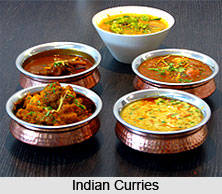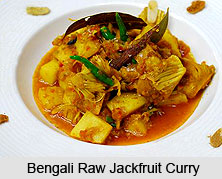 Curry is an incorporation of complex combinations of spices or herbs, usually including fresh or dried hot chillies. The decisive identity of India with the world starts with the flavours of the ubiquitous curry. It has successfully arrested the fascination of the globe all through. It is one delicacy that is prepared with different variations by different chefs.
Curry is an incorporation of complex combinations of spices or herbs, usually including fresh or dried hot chillies. The decisive identity of India with the world starts with the flavours of the ubiquitous curry. It has successfully arrested the fascination of the globe all through. It is one delicacy that is prepared with different variations by different chefs.The origin of the word 'Curry' comes from the Tamil word 'Kari', which is a blend of spices and sauces, chiefly coconut. Curry may contain meat, poultry, fish, or shellfish, either alone or in combination with vegetables. Many are instead entirely vegetarian, especially among those who hold ethical or religious values against eating meat or seafood. However, it has spread all over the country with varieties sprouting up in every Indian province.
In original traditional cuisines, the precise selection of spices for each dish is a matter of regional cultural tradition and religious practice. Such dishes are called by specific names that refer to their ingredients, spicing, and cooking methods.
Traditionally, spices are used both whole and ground; cooked or raw; and they may be added at different times during the cooking process to produce different results. The main spices found in most curry powders are turmeric, coriander, and cumin; a wide range of additional spices may be included depending on the geographic region. Curries may be either ‘wet’ or ‘dry’. Wet curries contain significant amounts of sauce or gravy based on yoghurt, coconut milk, dal or stock. Dry curries are cooked with very little liquid which is allowed to evaporate, leaving the other ingredients coated with the spice mixture.
 The evolvement of curry in India has now led to a fantastic amalgamation of international cuisines, with the term being just not restricted to Indianised versions. It is usual to distinguish broadly between regional styles of Indian cuisine, recognizing that within those categories are innumerable sub-styles and variations. The distinction is commonly made with reference to the staple starch: wheat in the form of unleavened breads in the north; rice in the east; rice and millet in the south.
The evolvement of curry in India has now led to a fantastic amalgamation of international cuisines, with the term being just not restricted to Indianised versions. It is usual to distinguish broadly between regional styles of Indian cuisine, recognizing that within those categories are innumerable sub-styles and variations. The distinction is commonly made with reference to the staple starch: wheat in the form of unleavened breads in the north; rice in the east; rice and millet in the south.For more, visit the link below: